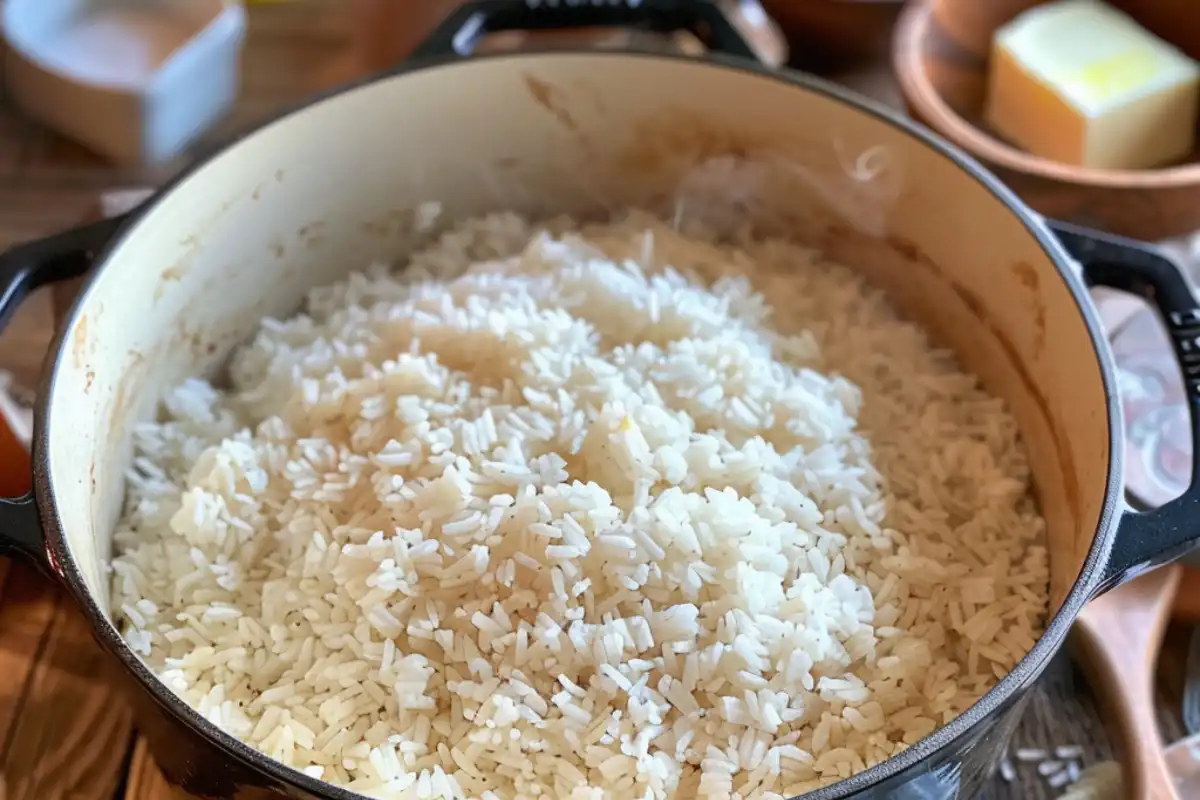Cooking rice perfectly in a Dutch oven can be a rewarding experience. A Dutch oven is renowned for its versatility, durability, and ability to cook food evenly. However, one of the common frustrations many people face when using this cookware is figuring out how to keep rice from sticking to a Dutch oven. Sticky rice can be problematic, leaving you with both burnt rice and a difficult cleanup.
In this article, we’ll explore the best ways to keep rice from sticking to a Dutch oven, starting with common mistakes and ending with a comprehensive step-by-step guide. Additionally, we’ll cover essential cooking techniques and methods to ensure fluffy, non-sticky rice every time.
Table of Contents
Why Does Rice Stick to a Dutch Oven? 🤔
Rice sticking to the bottom of a Dutch oven happens for several reasons, most of which can be controlled. The typical reasons include:
- Insufficient Water: Too little water causes rice to dry out and stick.
- High Cooking Temperature: Cooking rice at high heat burns the bottom while leaving the rest undercooked.
- Not Rinsing the Rice: Starch makes rice sticky; rinsing helps remove excess starch.
- Stirring Too Much: Over-stirring releases starch and makes rice clump together.
Common Mistakes When Cooking Rice in a Dutch Oven
1. Using the Wrong Water-to-Rice Ratio
Different rice types require varying water amounts. Here are general guidelines:
- White Rice: 1.5 to 2 cups of water per cup of rice.
- Brown Rice: 2.5 to 3 cups of water per cup of rice.
- Jasmine/Basmati Rice: 1.25 to 1.5 cups of water per cup of rice.
2. Cooking on Too High Heat
Start at medium heat to bring water to a boil, then reduce to low to simmer gently.
3. Lifting the Lid Too Often
Opening the lid releases steam, leading to uneven cooking and dryness at the bottom.

For a complete meal, try pairing your perfectly cooked rice with this Dutch Oven Chicken and Rice recipe, which brings together tender chicken and flavorful rice in one pot
How to Properly Rinse Rice Before Cooking 🚰
Rinsing removes excess starch, preventing clumping and stickiness.
Steps for Rinsing Rice:
- Measure the Rice: Use the desired amount.
- Rinse Under Cold Water: Swirl in a bowl, drain, and repeat until the water runs clear.
- Let the Rice Drain: Use a fine mesh sieve for a few minutes.
Why is this step so important? If you don’t rinse the rice, the residual starch will thicken as the rice cooks, making it sticky and more likely to cling to the Dutch oven. Discover more about why rinsing rice is important in this article from The Kitchn
Using Oil or Butter to Keep Rice from Sticking 🧈
Adding a layer of fat creates a barrier between the rice and the Dutch oven.
Steps:
- Add Oil: Drizzle 1-2 tablespoons of olive oil, avocado oil, or butter into the pot.
- Spread Evenly: Coat the bottom and sides of the pot.
- Add Rice and Water: Proceed with cooking.
Consider serving your perfectly cooked rice with flavorful sides like this salmon spinach dish.
Temperature and Cooking Time for Dutch Oven Rice ⏳
1. Bring to a Boil
- Start at medium heat until boiling.
2. Simmer Gently
- Reduce heat to low and cover with a lid.
Cooking Times:
- White Rice: 15-18 minutes
- Brown Rice: 40-45 minutes
- Basmati/Jasmine Rice: 12-15 minutes
3. Steam After Cooking
- Remove from heat and let rice sit with the lid on for 5-10 minutes before fluffing with a fork.
Stirring Techniques to Keep Rice from Sticking 🍚
- Minimal Stirring: Only stir lightly before placing the lid.
- Post-Cooking Stirring: Fluff rice after steaming, not during cooking.
Cleaning a Dutch Oven After Cooking Rice 🧽

Even with precautions, rice may still stick. Here’s how to clean it properly:
Cleaning Steps:
- Soak the Pot: Fill with warm water and let sit for 10-15 minutes.
- Use a Wooden Spoon: Gently scrape off stuck rice.
- Avoid Harsh Cleaners: Use mild dish soap and avoid abrasive scrubbing.
For more detailed cleaning tips, check out this guide on how to clean a Dutch oven.
Keep Rice from Sticking to a Dutch Oven Every Time 🎉🍚
Cooking rice in a Dutch oven doesn’t have to be frustrating. By rinsing your rice, using the correct water-to-rice ratio, and cooking at a controlled temperature, you can keep rice from sticking to a Dutch oven and enjoy perfectly cooked, fluffy rice every time.
For a savory snack before the main meal, try making these homemade cheddar crackers.
Frequently Asked Questions (FAQs) ❓
1. How do I keep rice from burning in a Dutch oven?
- Use enough water, cook on low heat, and avoid lifting the lid frequently.
2. Can I cook sticky rice in a Dutch oven without it sticking?
- Yes! Use the proper water-to-rice ratio and steam the rice after cooking.
3. Why does my rice keep sticking even with more water?
- You may be cooking at too high a temperature. Reduce heat to low and keep the lid on.
4. Should I use non-stick spray for cooking rice in a Dutch oven?
- Non-stick spray can help, but oil or butter is usually enough to create a non-stick barrier.
5. Is a cast-iron Dutch oven better for cooking rice?
- Yes! A cast-iron Dutch oven with an enamel coating evenly distributes heat and prevents sticking when used properly.

